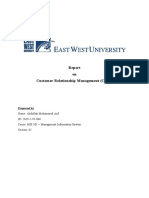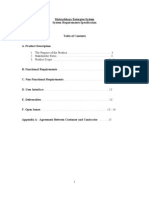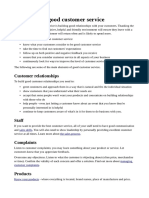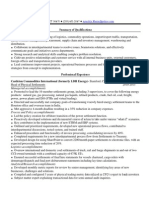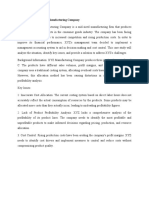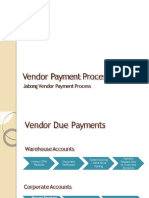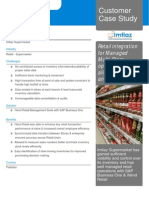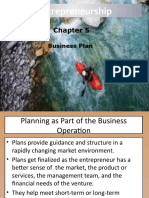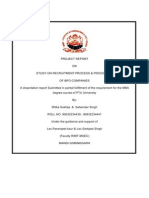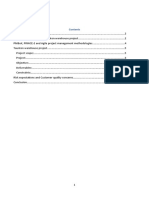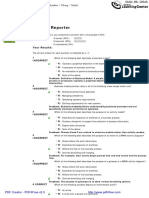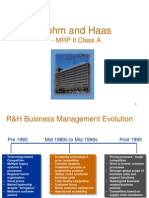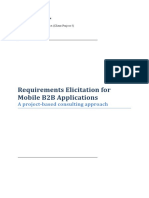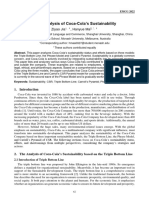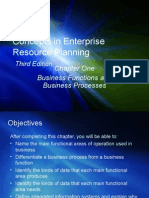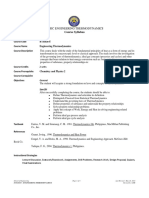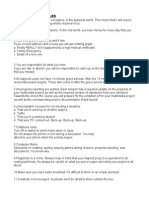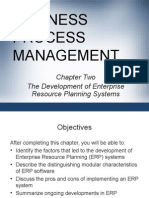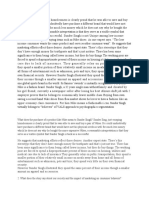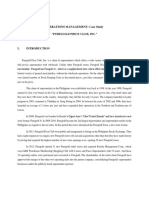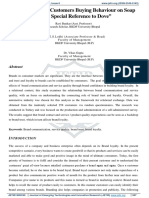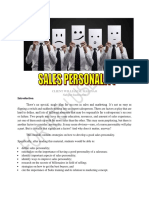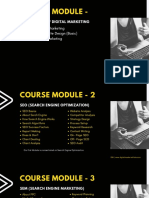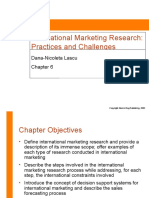BUSINESS PROCESS
MANAGEMENT
Chapter One
Business Functions and Business Processes
�Objectives
2
After completing this chapter, you will be able to:
Name the main functional areas of operation used in
business
Differentiate a business process from a business
function
Identify the kinds of data that each main functional
area produces
Identify the kinds of data that each main functional
area needs
Define integrated information systems and explain why
they are important
Concepts in Enterprise Resource Planning, Third Edition
�Introduction
3
Enterprise Resource Planning (ERP) programs:
Core software used by companies to coordinate
information in every area of business
Help
manage companywide business processes
Use common database and shared management
reporting tools
Business process: Collection of activities that takes
some input and creates an output that is of value to
the customer
Concepts in Enterprise Resource Planning, Third Edition
�Functional Areas and Business Processes
4
To understand ERP, you must understand how a
business works
Functional
areas of operation
Business processes
Concepts in Enterprise Resource Planning, Third Edition
�Functional Areas of Operation
5
Marketing and Sales (M/S)
Supply Chain Management (SCM)
Accounting and Finance (A/F)
Human Resources (HR)
Business functions: Activities specific to a functional
area of operation
Concepts in Enterprise Resource Planning, Third Edition
�Functional Areas of Operation (contd.)
6
Figure 1-1 Examples of functional areas of operation and their business
functions
Concepts in Enterprise Resource Planning, Third Edition
�Functional Areas of Operation (contd.)
7
Functional areas are interdependent
Each
requires data from the others
Better integration of functional areas leads to
improvements in communication, workflow, and
success of company
Information system (IS): Computers, people,
procedures, and software that store, organize, and
deliver information
Concepts in Enterprise Resource Planning, Third Edition
�Business Processes
8
Collection of activities that takes one or more kinds
of input and creates an output that is of value to
customer
Customer
can be traditional external customer or
internal customer
Thinking in terms of business processes helps
managers to look at their organization from the
customers perspective
Concepts in Enterprise Resource Planning, Third Edition
�Business Processes (contd.)
9
Figure 1-2 Sample business processes related to the sale of a
personal computer
Concepts in Enterprise Resource Planning, Third Edition
�Business Processes (contd.)
10
Businesses must always consider customers
viewpoint in any transaction
Successful customer interaction
Customer
(either internal or external) is not required to
interact with each business function involved in the
process
Successful business managers view business
operations from the perspective of a satisfied
customer
Concepts in Enterprise Resource Planning, Third Edition
�Business Processes (contd.)
11
Sharing data effectively and efficiently between
and within functional areas leads to more efficient
business processes
Integrated information systems: Systems in which
functional areas share data
Concepts in Enterprise Resource Planning, Third Edition
�Business Processes (contd.)
12
Figure 1-3 A process view of business
Concepts in Enterprise Resource Planning, Third Edition
�Business Processes (contd.)
13
Businesses take inputs (resources) and transform
these inputs into goods and services for customers
Inputs:
Material, people, equipment
Managing inputs and business processes effectively
requires accurate and up-to-date information
Concepts in Enterprise Resource Planning, Third Edition
�Functional Areas and Business Processes
of a Very Small Business
14
Example: A fictitious lemonade stand
Examine
business processes of the lemonade stand
See why coordination of functional areas helps achieve
efficient and effective business processes
Look at how integration of the information system
improves the business
Concepts in Enterprise Resource Planning, Third Edition
�Marketing and Sales
15
Functions of Marketing and Sales
Developing
products
Determining pricing
Promoting products to customers
Taking customers orders
Helping create a sales forecast
Concepts in Enterprise Resource Planning, Third Edition
�Marketing and Sales (contd.)
16
Marketing and Sales tasks for the lemonade stand
Formal
recordkeeping not required
Need to keep track of customers
Product development can be done informally
Good repeat customers allowed to charge purchases
up to a point
Records
must show how much each customer owes and his or
her available credit
Concepts in Enterprise Resource Planning, Third Edition
�Supply Chain Management
17
Functions within Supply Chain Management
Making
the lemonade (manufacturing/production)
Buying raw materials (purchasing)
Production planning requires sales forecasts from
M/S functional area
Sales
forecasts: Analyses that attempt to predict the
future sales of a product
Concepts in Enterprise Resource Planning, Third Edition
�Supply Chain Management (contd.)
18
Production plans used to develop requirements for
raw materials and packaging
Raw
materials: Bottled spring water, fresh lemons,
artificial sweetener, raw sugar
Packaging: Cups, straws, napkins
SCM and M/S must choose a recipe for each
lemonade product sold
Concepts in Enterprise Resource Planning, Third Edition
�Accounting and Finance
19
Functions within Accounting and Finance
Recording
raw data about transactions (including sales),
raw material purchases, payroll, and receipt of cash
from customers
Raw data: Numbers collected from those
operations, without any manipulation, calculation, or
arrangement for presentation
Concepts in Enterprise Resource Planning, Third Edition
�Accounting and Finance (contd.)
20
Data from Accounting and Finance used by
Marketing and Sales and Supply Chain
Management
Sales
records are important component of sales
forecast
Sales forecast is used in making staffing decisions and
in production planning
Records from accounts receivable used to monitor the
overall credit-granting policy of the lemonade stand
Concepts in Enterprise Resource Planning, Third Edition
�Human Resources
21
Functions of Human Resources
Recruit,
train, evaluate, and compensate employees
HR uses sales forecasts developed by the individual
departments to plan personnel needs
Systems integrated using ERP software provide the
data sharing necessary between functional areas
Concepts in Enterprise Resource Planning, Third Edition
�Functional Area Information Systems
22
Potential inputs and outputs for each functional area
described next
Note the kinds of data needed by each area and
how people use the data
Information systems maintain relationships between
all functional areas and processes
Concepts in Enterprise Resource Planning, Third Edition
�Marketing and Sales
23
Needs information from all other functional areas
Customers communicate orders to M/S in person or
by telephone, e-mail, fax, the Web, etc.
M/S has a role in determining product prices
Pricing
might be determined based on a products unit
cost, plus some percentage markup
Requires information from Accounting and Finance, and
Supply Chain Management data
Concepts in Enterprise Resource Planning, Third Edition
�Marketing and Sales (contd.)
24
Figure 1-4 The Marketing and Sales functional area exchanges data with
customers and with the Human Resources, Accounting and Finance, and
Supply Chain Management functional areas
Concepts in Enterprise Resource Planning, Third Edition
�Marketing and Sales (contd.)
25
M/S needs to interact with Human Resources to
exchange information on hiring needs, legal
requirements, etc.
Inputs for M/S
Customer
data
Order data
Sales trend data
Per-unit cost
Travel expense company policy
Concepts in Enterprise Resource Planning, Third Edition
�Marketing and Sales (contd.)
26
Outputs for M/S
Sales
strategies
Product pricing
Employment needs
Concepts in Enterprise Resource Planning, Third Edition
�Supply Chain Management
27
Needs information from various functional areas
Production plans based on information about
product sales (actual and projected) that comes
from Marketing and Sales
With accurate data about required production
levels:
Raw
material and packaging can be ordered as
needed
Inventory levels can be kept low, saving money
Concepts in Enterprise Resource Planning, Third Edition
�Supply Chain Management (contd.)
28
Supply Chain Management data and records can:
Provide
data needed by Accounting and Finance to
determine how much of each resource was used
Support the M/S function by providing information
about what has been produced and shipped
Supply Chain Management interacts in some ways
with Human Resources
Concepts in Enterprise Resource Planning, Third Edition
�Supply Chain Management (contd.)
29
Figure 1-5 The Supply Chain Management functional area exchanges data
with suppliers and with the Human Resources, Marketing and Sales, and
Accounting and Finance functional areas
Concepts in Enterprise Resource Planning, Third Edition
�Supply Chain Management (contd.)
30
Inputs for SCM
Product
sales data
Production plans
Inventory levels
Layoff and recall company policy
Concepts in Enterprise Resource Planning, Third Edition
�Supply Chain Management (contd.)
31
Outputs for SCM
Raw
material orders
Packaging orders
Resource expenditure data
Production and inventory reports
Hiring information
Concepts in Enterprise Resource Planning, Third Edition
�Accounting and Finance
32
Needs information from all other functional areas
A/F personnel:
Record
companys transactions in the books of account
Record accounts payable when raw materials are
purchased and cash outflows when they pay for
materials
Summarize transaction data to prepare reports about
companys financial position and profitability
Concepts in Enterprise Resource Planning, Third Edition
�Accounting and Finance (contd.)
33
People in other functional areas provide data to
A/F
M/S
provides sales data
SCM provides production and inventory data
HR provides payroll and benefit expense data
M/S personnel require data from A/F to evaluate
customer credit
Concepts in Enterprise Resource Planning, Third Edition
�Accounting and Finance (contd.)
34
Figure 1-6 The Accounting and Finance functional area exchanges data with
customers and with the Human Resources, Marketing and Sales, and Supply
Chain Management functional areas
Concepts in Enterprise Resource Planning, Third Edition
�Accounting and Finance (contd.)
35
Inputs for A/F
Payments
from customers
Accounts receivable data
Accounts payable data
Sales data
Production and inventory data
Payroll and expense data
Concepts in Enterprise Resource Planning, Third Edition
�Accounting and Finance (contd.)
36
Outputs for A/F
Payments
to suppliers
Financial reports
Customer credit data
Concepts in Enterprise Resource Planning, Third Edition
�Human Resources
37
HR needs information from the other departments
Tasks related to employee hiring, benefits, training,
and government compliance are all responsibilities
of HR
HR needs accurate forecasts of personnel needs
from all functional units
HR needs to know what skills are needed to
perform a particular job and how much the
company can afford to pay employees
Concepts in Enterprise Resource Planning, Third Edition
�Human Resources (contd.)
38
Figure 1-7 The Human Resources functional area exchanges data with the
Accounting and Finance, Marketing and Sales, and Supply Chain
Management functional areas
Concepts in Enterprise Resource Planning, Third Edition
�Human Resources (contd.)
39
Observing governmental regulations in recruiting,
training, compensating, promoting, and terminating
employees
Inputs for HR
Personnel
forecasts
Skills data
Concepts in Enterprise Resource Planning, Third Edition
�Human Resources (contd.)
40
Outputs for HR
Regulation
compliance
Employee training and certification
Skills database
Employee evaluation and compensation
Concepts in Enterprise Resource Planning, Third Edition
�Human Resources (contd.)
41
Significant amount of data is maintained by and
shared among the functional areas
Timeliness and accuracy of these data are critical to
each areas success and to companys ability to
make a profit and generate future growth
ERP software allows all functional areas to share a
common database
Allows
accurate, real-time information to be available
Concepts in Enterprise Resource Planning, Third Edition
�Summary
42
Basic functional areas: Marketing and Sales, Supply
Chain Management, Accounting and Finance, and
Human Resources
Marketing and Sales: Sets product prices, promotes
products through advertising and marketing, takes
customer orders, supports customers, and creates sales
forecasts
Supply Chain Management: Develops production plans,
orders raw materials from suppliers, receives raw
material, manufactures products, maintains facilities,
and ships products to customers
Concepts in Enterprise Resource Planning, Third Edition
�Summary (contd.)
43
Accounting and Finance: Financial accounting to provide
summaries of operational data in managerial reports,
controlling accounts, planning and budgeting, and cashflow management
Human Resources: Recruits, hires, trains, and
compensates employees, ensures compliance with
government regulations, and oversees the evaluation of
employees
Information systems capture, process, and store data to
provide information needed for decision making
Concepts in Enterprise Resource Planning, Third Edition
�Summary (contd.)
44
Employees working in one functional area need
data from employees in other functional areas
Functional
area information systems should be
integrated, so shared data are accurate and timely
Managers think in terms of business processes that
integrate the functional areas
Need
to share information between functions and
functional areas
ERP software provides this capability by means of a
single common database
Concepts in Enterprise Resource Planning, Third Edition

